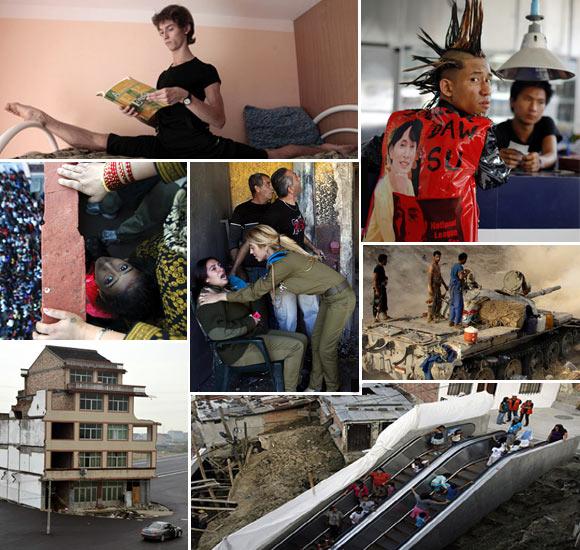
In the third part of our series on the best photographs of 2012 we bring you pictures as varied as the conflict in Israel, to the Bisket festival in the ancient city of Bhaktapur near Kathmandu; from the bullrings of Spain to the New York fashion week.
To see the first and second part of this series, click below;
Click on NEXT to go through this presentation...
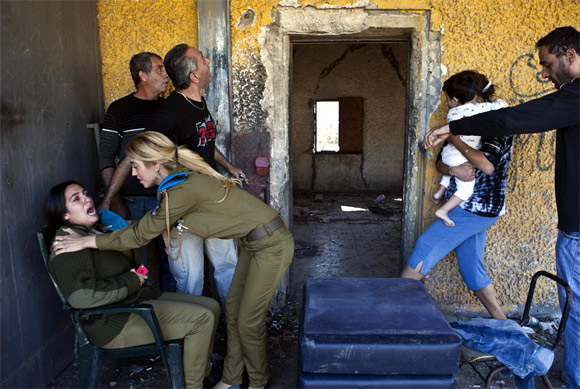
"I was driving on my way to the scene where a rocket had hit a 4-storey building when I heard sirens warning of incoming rockets. I stopped my car and saw people running from three different directions, two of them were female soldiers, one mother holding her baby and another two men. All the people in the picture were random people that were walking in the street at the time of the siren.
I was on assignment covering the situation in southern Israel. The picture did not take long to take, I concentrated for a few seconds to try and make a picture out of all the chaos. I was also running when I heard the siren. I felt sympathy for the people in the picture who were in an extreme situation. About five minutes after the siren I went back to my car and continued to the scene where the rocket had hit a building."
Click NEXT to see more PHOTOS...
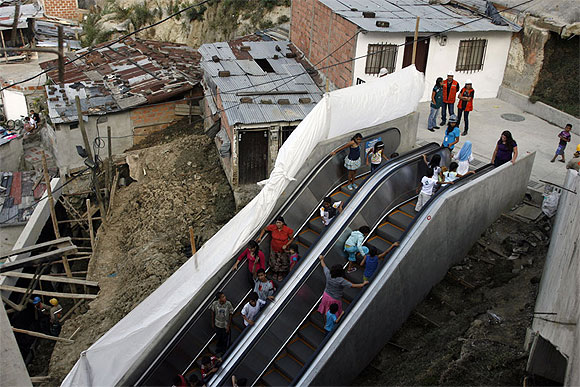
"I went to photograph the great novelty in Commune 13 of Medellin, something that filled residents of the neighborhood and the whole city with curiosity. I was also intrigued since I know that neighborhood as a violent one and I know what life is like there; illegal armed groups fight for control of the zone where poverty and violence are common, amid many good people with brave hearts who overcome adversity.
Half the community was against the escalator, saying that there were more important needs, and the other half applauded it as bringing them a new light, making them feel less neglected. It turned the neighborhood into a tourist attraction opening possibilities for new cafes, hairdressers, shops, and even street vendors. During my ride up the escalator I crossed paths with beautiful girls, residents going about their daily tasks, Filipino, French, Canadian and Spanish tourists, and armed gangs trying to make this project work in their benefit.
I managed to access the positions from where I wanted to photograph, and took this photo that for me holds the contrast of the different existing realities. There are the modern, shiny escalators in the middle of poverty. It was a day of visual impact for me, to watch children who didn't rest from riding up and down the escalator that enriched a poor neighborhood plagued by violence, within an invisible border."
Click NEXT to see more PHOTOS...
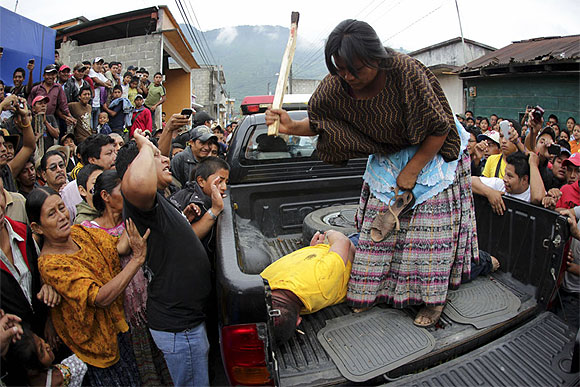
"It was a confusing situation. Early morning, the day after the lynching of a man who killed two children in a school with a machete, the people of the town captured four men accused of being accomplices to the lynched man. In the end the men were identified as thieves, people wanted to lynch them, burn them alive, and the police just watched, doing nothing.
The men were rescued by additional police and a mediator, and were taken to the outskirts of town, where they were evacuated by army vehicle. This was the first time I was afraid to be in a difficult situation. It was as if people only wanted revenge for the death of the two children killed the day before in the school.
Click NEXT to see more PHOTOS...

"Right now, buying a house like this would cost me more than 2 million yuan, but the government only offered me 260,015 to move, where could I go?" 67-year-old Luo Baogen said while smoking a cigarette in front of his partially demolished "nail house", standing alone in the middle of a road in Wenling city, China's eastern Zhejiang province. "Nail house" refers to the last houses in an area owned by people who refuse to move to make room for new developments.
About 500 kilometers (310 miles) from Shanghai, this house quickly became an Internet hot topic after local news reports bearing dramatic photographs went public.
It was difficult to believe that such a small city of Wenling was also undergoing great changes like Shanghai. On my train ride, I could see big and small construction sites on both sides of the railway. As soon as I stepped off the train, I could hear many noises of heavy machinery, constant reminders of the fast GDP development in this country.
I knew most of the "nail house" problems were as consequences of economic developments. This one was no exception.
After a brief interview, we learned that Luo Baogen and his wife were farmers who used to live in a quiet village too small to be found on Google map, with a few houses and some crop fields around the area. But just a few years ago, the high-speed railway ran through this village, and the local government decided to take advantage to turn this place into an economic development zone. Negotiation and demolition kicked off. Fast forward to today, and Luo and his wife are the last family refusing to move.
Luo told us he was distressed as feedback from the government changed all the time. He didn't know what else he could do, so he just waits day after day by his house, puffing on cigarettes.
While we were interviewing Luo, dozens of other villagers came to us to complain about the local government's behavior, but all of them asked to be off-the-record. In the meantime, an unidentified man kept using a mobile phone to take pictures of us to keep us on record.
I have covered several nail house stories in my photojournalism career, and sometimes, I can feel the same powerlessness and tininess as my interviewees, being in the way of the development of a fast-growing nation.
I sincerely hope that there will be a happy ending for this couple. I believe honest people like them, and many other citizens, deserve better, as they have already given so much to society."
Click NEXT to see more PHOTOS...
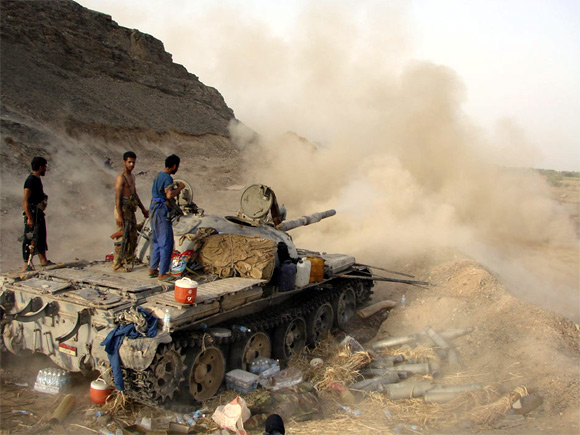
"As the Yemeni army troops were pushing ahead with a US-backed offensive to recapture main cities in the restive southern province of Abyan from the hands of Al Qaeda-linked militants with tank and artillery shelling, the defence ministry provided a dozen frames from the frontline of battles, including this image.
Al Qaeda-linked militants seized large swathes of territory in southern Yemen last year as then-President Ali Abdullah Saleh grappled with protesters demanding his overthrow. Saleh has quit in favor of his deputy, Abd-Rabbu Hadi Mansour, who was elected as president last February."
Click NEXT to see more PHOTOS...

"It was the final day of the nine day long festival and a huge crowd had gathered at Bhaktapur to observe the Bisket festival. Even the roofs, windows and balconies of the nearby houses were packed with people observing the festival. Everyone was looking for the best and the safest spot from where they could observe and enjoy the festival. I saw one house that was ideal for me to take pictures from but I couldn't just crash into someone's house without permission.
I took my chance and rang the door bell. After some time a man looked out from the window of this house - he was the owner. I smiled at him and requested if I could go to the roof of his house to take some pictures of the festival. He asked are you from the press? I said yes and showed him my journalist ID card that was hanging around my neck. He told me to wait and he came down to open the door. After looking closely at the ID card and few more questions he allowed me to enter his house. I thanked him and went straight towards the roof which was filled with people.
I took a spot from where I could shoot pictures of the festival but I had not noticed this girl in the picture sitting with her mother until I heard her mother speaking with her. As soon as I saw her I noticed that this could be a good picture so I started to take photos of this girl after receiving permission from her mother. There's a variation of crowd and isolation in one picture that I like a lot."
Click NEXT to see more PHOTOS...

"Campaign rallies are so alike, so much so, it can seem like you are covering the same rally over and over again. You rarely remember what state or city you are in. The only thing that makes them different is when you can actually shoot something you have not seen at other rallies.
At this particular rally, since it was so bright outside, an opaque teleprompter was used. Having been uninspired by what I saw from my position up close, I roamed to the back of the rally. From there, I was able to see the way the teleprompter obscured President Obama's face; in fact, it appeared to replace his head entirely."
Click NEXT to see more PHOTOS...

"Shooting the shuttle's arrival and transport to its new home was a much-anticipated event in the Los Angeles Times photo department. Nearly every photographer was involved at some point along the journey – from creating time-lapse images to flying overhead, everyone played a part.
I was excited to photograph the shuttle that had long ago replaced the Challenger shuttle, which I watched explode with my own eyes from a second-floor window of my high school during my 10th grade year. That was a truly tragic event and this was a chance to come full circle with a joyous occasion for Angelinos.
My assignment was to follow the space shuttle Endeavour -- on foot, which began for me at about 6 in the morning. Before the day was over I'd spent 17 hours walking much of the 12-mile distance the shuttle travelled from Los Angeles International Airport to the California Science Center.
A substantial crowd lined the sidewalks as it moved slowly through the streets of Los Angeles, much of it through neighborhoods with lower socioeconomic situations. I'm sure for many who saw it from their windows or balconies it might be the only time they ever lay eyes on it. As it moved, I tried to anticipate where an interesting juxtaposition might occur between the Endeavour and its surroundings. Sometimes racing ahead, sometimes deliberately staying behind, I climbed up on roofs, begged my way into houses – anything to try to put myself in a good position.
For this image, which was made along Crenshaw Drive, I found a second floor balcony that afforded a nice view of people crowding the balconies on the opposite side of the street. But what caught my eye more than that was the lone man standing on the roof as the enormous nose cone of the shuttle crawled into view.
I don't think I need to see the shuttle in its new museum space. The site of the Endeavour dominating the streets of Los Angeles is forever burned into my memory."
Click NEXT to see more PHOTOS...
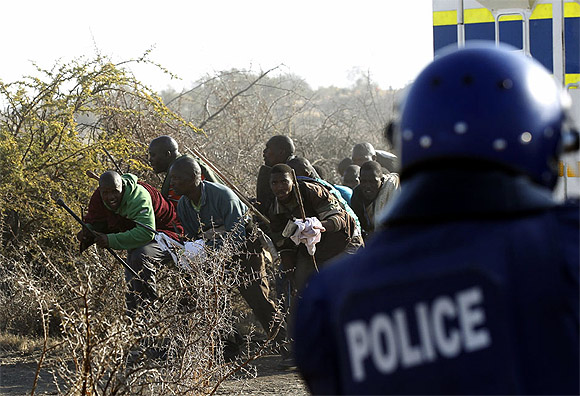
"I had found what I thought was a safe spot from the side of a Nyala (an armored police vehicle) when the miners armed with machetes and sticks (one of the men in the picture is carrying a firearm in his right hand) approached the police. I knew this would not end well. It had reached a boiling point and from my "safe spot" there was no way of getting a picture. At the same time I had inhaled teargas that the police had fired at the miners.
I used the opportunity to take a few frames from behind the policeman when he was firing at them. I managed to capture the fear in the face of the miners. A few seconds after that most of them were dead and some badly injured."
Click NEXT to see more PHOTOS...
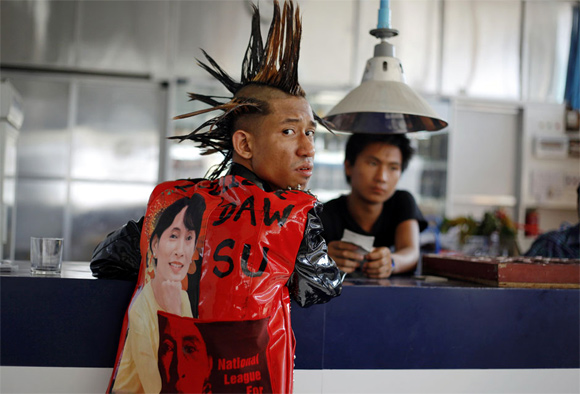
"This picture was taken during the Punk Music Show as they celebrated Myanmar's New Year water festival in Yangon. When I asked, he told me that he had made the jacket himself. He loves Aung San Suu Kyi very much and that's why he wears it."
Click NEXT to see more PHOTOS...
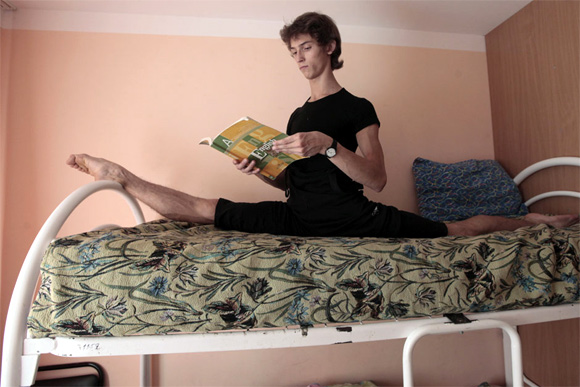
"There is a new tradition in Krasnoyarsk, once every two years there is a weeklong ballet forum. Famous figures from the Russian ballet come to the city for a series of shows, seminars and other events. One of the main events is a competition amongst the most talented young performers from different types of ballet for a prize of performing with the stars in town. I had the idea to follow some of the participants, knowing that the physical and psychological stresses are immense, and to see how they prepare for this challenge.
Having got the access I required, I chose a pair of young dancers from south Siberia who had already won awards across the county -- Marina Volkova, 16, and Yuri Kudryatsev, 18, -- both of whom had studied ballet from the age of 4. I followed them for a couple of days before the competition and saw their complete dedication, how they exhausted themselves and the reactions of their tutors to the slightest mistake.
This photograph showing Yuri studying English whilst doing the splits on the top bunk in his dormitory was part of the story. The preparation regime that these young people embark upon I can only compare to an Olympic class athlete, as they mix their training with all other student activities. You can watch TV as you stretch ligaments on a training machine, or do your homework, like Yuri here, as you train your muscles into certain poses. Where else could you see this but in the dormitory of future ballet stars? The rest was easy; all I had to do was press the shutter button.
Marina and Yuri later confirmed the hopes of their teachers, receiving prizes from the Krasnoyark Governor and Mayor of Krasnoyarsk for 2nd and 3rd prizes in the personal category respectively."
Click NEXT to see more PHOTOS...

"I met Joseba Etxaburu while photographing the San Fermin festival in Pamplona, which happens to be my hometown, in 2005. I had already heard stories about this Basque fireman turned photographer and was eager to meet him. A photo of his of a bull attempting to gore a runner at the entrance to the bullring was one of the most amazing ones I had seen of the bull run so far.
At the time I started working with him, Joseba was getting a kick out of shooting "Las Vaquillas"; the release of wild cows into the bullring following the running of the bulls. Revelers entertain themselves after the bull run trying to dodge young cows and we, photographers, can't resist taking photos of them getting tossed in the air. Joseba got tired of shooting the action from the stands with a 70-200mm lens and decided to get down and dirty. That means going into the bullring with a wide angle lens and shooting the revelers and the heifers that chase them, up close and personal.
That has become his trademark. Joseba is willing to take risks and that shows in his photographs. I'm not sure whether it has to do with his training as a fireman or it's just a character trait, or possibly both, but the truth is that no one shoots "Las Vaquillas" like he does, most of us don't dare to! He's bold and has fast reflexes. Unfortunately this time, the wild cow was faster than him and I happened to be there to snap the picture (from the safety of the stands, I must admit).
After checking his camera was working properly and he had only minor scratches on his elbow he told me: "Susi, I'm OK. The only thing that got hurt is my pride, but I'm glad you were here to record this." It was the first time he had been tossed by a wild cow while shooting "Las Vaquillas".
Click NEXT to see more PHOTOS...

"After having a busy couple of weeks and being away covering events like Burning Man I had decided to travel to our family's cabin outside Pinedale, Wyoming for a weekend of rock climbing and hanging out. On our way back to the cabin one afternoon I got a call from my Dad who was several minutes ahead of me. He told me the forest was burning near our place and to meet him on the road above our cabin. I began racing as fast as I could not knowing if our place was in danger of being burned to the ground. Once I rounded a bend and could see beyond a mountain ridge a huge column of smoke it really hit me. I was forced to reconcile the idea that my loved ones were being directly impacted by a news story.
I got to the top of the ridge to meet my dad and step-mother. We watched the fire for awhile and watched it move in our general direction. One thing we felt good about is that our place was not in the trees and it would have to make a run of about two miles to get to us over open range land.
After a few minutes I decided I might as well cover the news. I always carry my fire gear in my truck and quickly changed on the side of the road and then sent my wife and dog with my Dad and step-mother in their car. I knew if I wanted to get something unique I had to go get in close to the fire now before a huge response team was in place and access was shut down.
I drove around the eastern flank of the fire to a rise where I could see some cabins and a pond but I always left an exit route for myself since the fire was moving in my direction. The smoke rolling into the canyon I was in was cutting off visibility but I was able to make frames of helicopters loading up with water from a pond. Right after I made the picture a sheriff deputy arrived and booted me from the area. It was a good call. I was about to leave anyways because the smoke was beginning to really cut off visibility and I knew the flames were just over the ridge."
Click NEXT to see more PHOTOS...
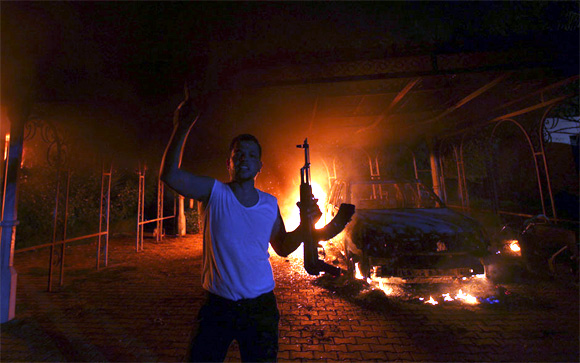
A protester reacts as the US Consulate in Benghazi seen in flames.
Click NEXT to see more PHOTOS...

"This image was made by reversing the standard exposure for a runway photo. Normally you expose for the models who are well lit, and the audience is reduced to a blurry, black background. With this photo I exposed for the audience, which caused the model to be over exposed. To increase the contrast, I waited for a model with blonde hair and wearing white. The result gives the appearance of a white silhouette of the model, and shows the audience watching her."
Click NEXT to see more PHOTOS...

"I'd just returned from shooting the tragic flooding in Krymsk when the following day I received a call offering me the opportunity to shoot an exclusive – a young man would sew his own mouth shut near the Kazan cathedral as a mark of support for the punk back Pussy Riot. I agreed and 20 minutes before the scheduled time called the "connected" person.
They were running late and so I waited another two hours. The man eventually arrived, with mouth already sewn, so I didn't have a chance to take the pictures of the sewing process which was disappointing, but I started to photograph the protesters. People were walking around him, provoking him, offending him, you could see the hate in their gaze – after all he was standing outside Kazan Cathedral, the main spiritual location for every orthodox Petersburg resident. I was concentrating on his face, trying to capture his stoic reaction to these proceedings, when all around there was hate and a feeling of moral pain and physical pain. (I asked one of his acquaintances who said that Peter had sewn his mouth without anesthetic).
This stoic and spiritual standoff was what I wanted to convey in the picture. The actual event looked very cruel – so I decided to shoot with a brutal crop – just mouth and eyes and stress the part of his black clothing – the symbol of mourning."
Click NEXT to see more PHOTOS...
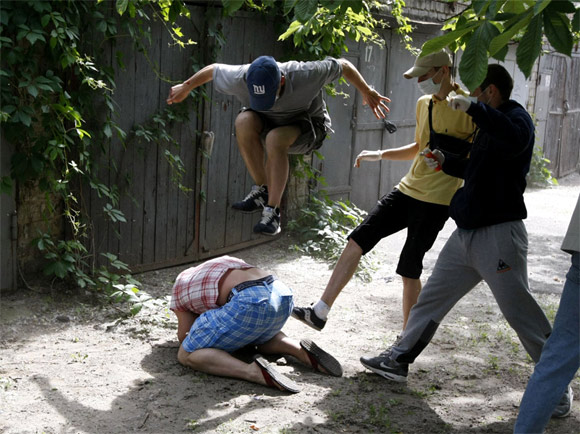
"That there was going to be a march by citizens of nontraditional sexual orientation, attracting LGBT representatives from Ukraine and Europe, created great excitement in the local society. This news brought together a number of diametrically opposite political parties such as "Svoboda" and "Orthodox choice". Originally planned for May 20, as the day approached a huge number of protest statements from different political and social parties appeared. The organising committee decided to postpone the event following threats of physical attacks.
This was announced at an improvised press conference in a park. It became clear during this that violence was a real possibility. A young man, paying no heed to the cameras and journalists, ran up to an organiser and sprayed gas in his face.
After the news conference the journalists dispersed. I myself was disappointed, it was hot and humid. The organiser went to get a taxi but I made sure I had a view of them as they left. Svyatoslav Sheremet and Maxim Kasyanchuk remained after the others had driven away. I lost sight of them but my attention was caught by a group of youths in masks that were chasing somebody. Intuitively I followed them to the yard of a nearby apartment block.
As I arrived I saw that they had caught up with Svyatoslav and Maxim. What I saw with my own eyes was wild and absurd -- literally a wolf pack had cornered its prey and was going to rip it to pieces. Only this was people. Obviously afraid of taking on Svyatoslav in an open fight the gang sprayed gas in his face, jumped him and started to beat him. It all happened in seconds, I ran to get closer and started photographing, and with me were two other photographers. The presence of the press was obviously not a part of the attackers plan, and when they saw us they ran off."
Click NEXT to see more PHOTOS...
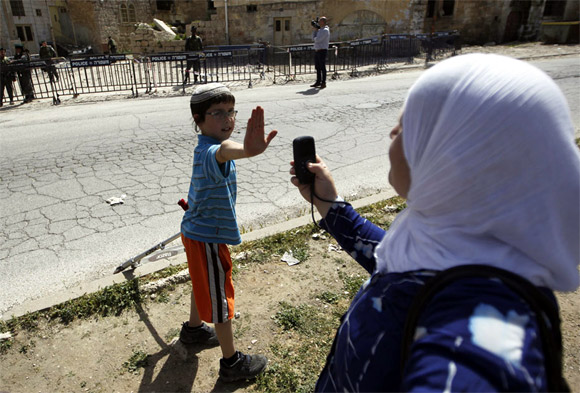
"I arrived in the morning to cover this story in the West Bank city of Hebron. I was told that Israeli police were planning to evict Jewish settlers from a building in the city and from my experience; these situations are usually highly volatile.
The settlers were removed from the building and then in protest they erected a tent outside the building. A Palestinian woman walked by and tried to photograph the scene on her mobile phone, when this young boy, one of the settlers, put his hand up in front of her phone."
Click NEXT to see more PHOTOS...

"On October 3rd, a day where most of my colleagues were covering the festivities to celebrate German unification, I had the opportunity to be an eyewitness to a Bavarian traditional event. The event was the so-called "Almabtrieb" on the lake Koenigssee, in one of the most beautiful regions of Southern Germany.
At the end of the summer season, farmers move their herds down from the Alps to the valley into winter pastures. The mountain pastures are often in remote areas only accessible by foot – or like the Koenigssee trail – by boat.
We met our guide before dusk to board an electric-powered boat to get to the far end of the lake where the farmer with his herd was supposed to arrive. The lake is known for its clear water and is advertised as the cleanest lake in Germany. For this reason, only electric-powered passenger ships, rowing and pedal boats are permitted on the lake. On this foggy, chilly dark morning I was happy that we didn't have to row. The hot tea from our captain kept everybody warm and awake.
After a 45 minute ride the sun came out and we were able to see the prettiness of the national park. Our captain stopped, brought out a trumpet and showed us the famous Koenigssee echo. Due to the lake's position surrounded by steep and narrow rock walls, sound creates an echo which can be heard reflected up to seven times – very impressive.
After another 30 minutes cruising with the sound of waterfowl and the purr of our boat engine, we arrived at the spot where two farmers with their herds were supposed to arrive to load the animals on a float carried by two boats with a permission to use outboard motors to transport the flock.
We could hear the cowbells as the first farmer with his animals came around the corner to board the float. It was a master feat for the herdsmen to navigate the 200 – 400 kg heavy ruminants on the boat.
The cows are covered with flowers if the whole herd has survived the summer. This time, the farmer had to mourn some animals – thus the drove would arrive "natural" at the village where, by that time, hundreds of tourists were waiting for the herdsman with his load.
I can imagine that the cows are looking forward to next spring when they will be back in their "quiet" shelter."
Click NEXT to see more PHOTOS...
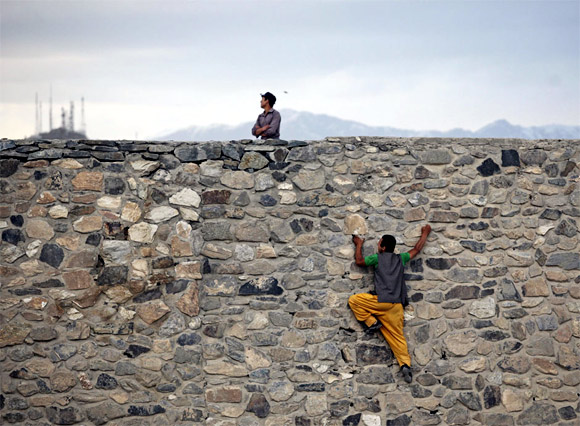
"I took this picture while photographing on a small hilltop which is one of the picnic spots for Afghans on Fridays. I noticed this man climbing a wall to surprise his friend who was already on the hill. The color of his pants and texture of the wall made it a picture for me."
Click NEXT to see more PHOTOS...

"This was the second shooting in less than six months for me. I awoke that morning at around 6am to emails informing me of the Aurora theater shooting and asking if I could get on a plane as soon as possible to Denver. Being from Ohio, Colorado, like the Chardon shooting, held a special place in my heart because I spent four years there in my early 20s.
I got in a plane and landed in Denver around noon and went straight to work. During a gathering of community members the day after the shootings I spotted this woman and did my best to make a photo of the woman under the technical nightmare of being badly backlit. I don't use flash so it was a little challenging."
Click NEXT to see more PHOTOS...
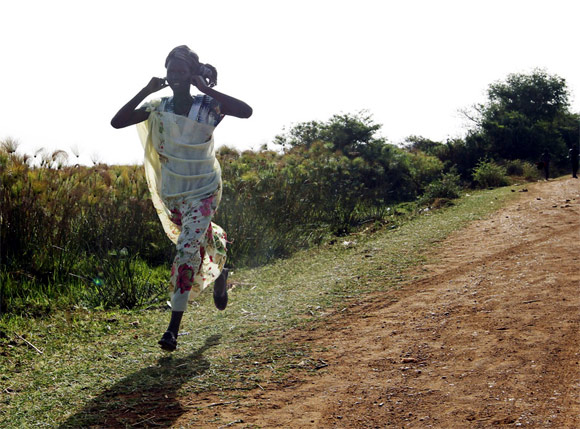
"I was travelling by car with some colleagues to the Sudan People's Liberation Movement (SPLM) headquarters when a fighter jet attacked the area and dropped a bomb about 150 meters away from us. This woman began running but really there's nowhere to run because you don't know where the next bomb will drop but people panic."
...